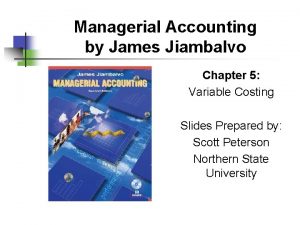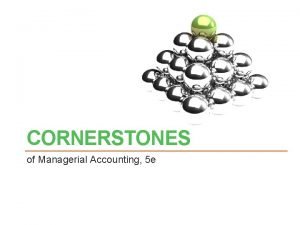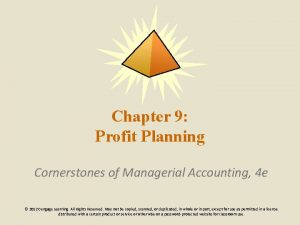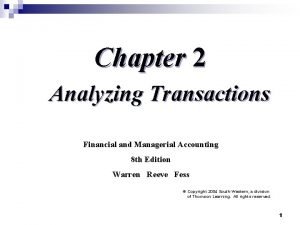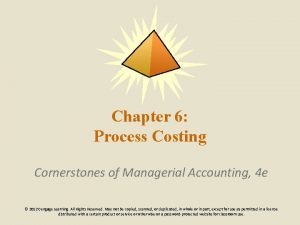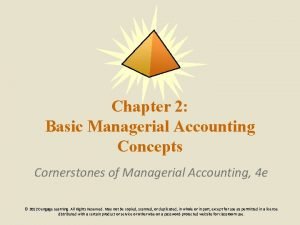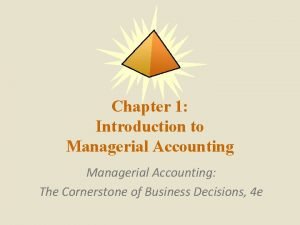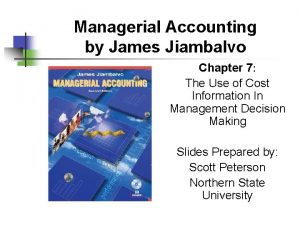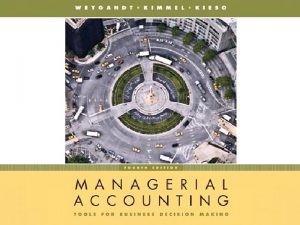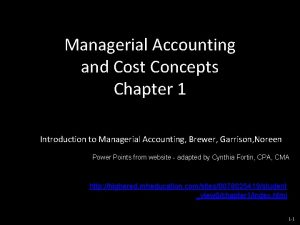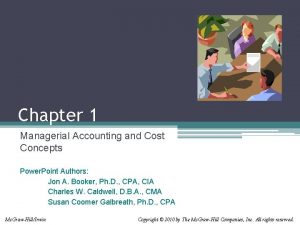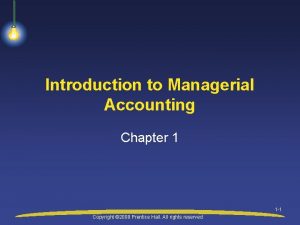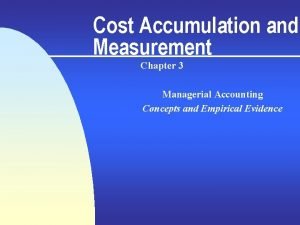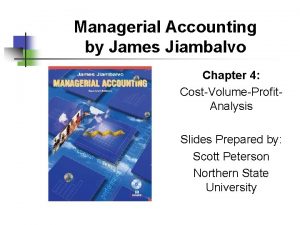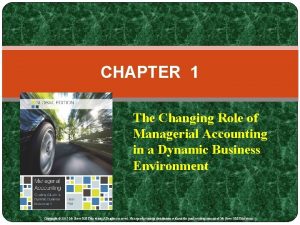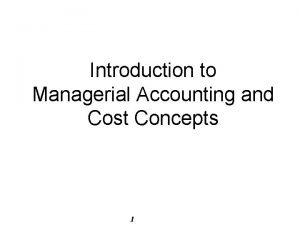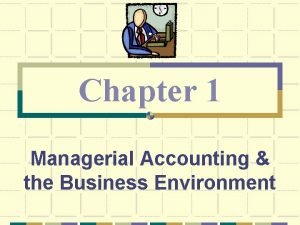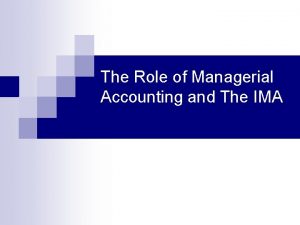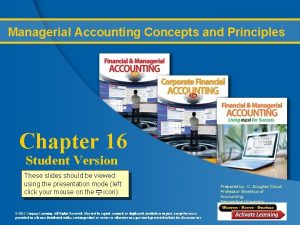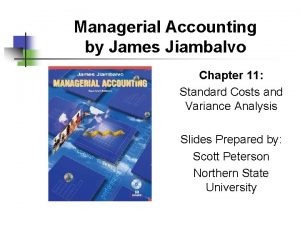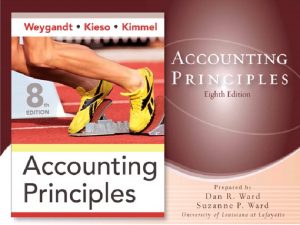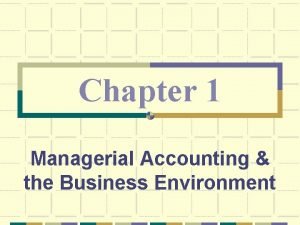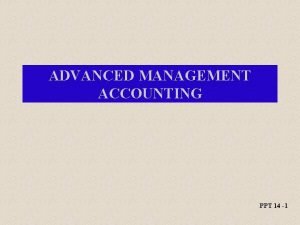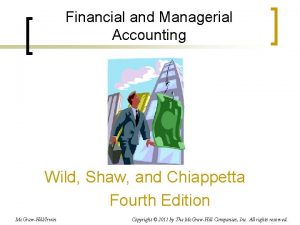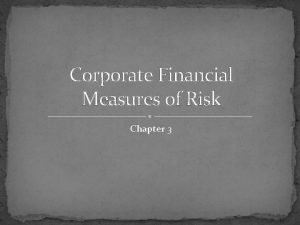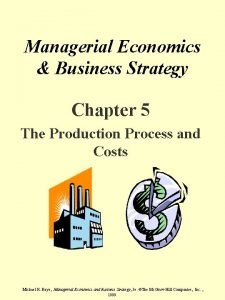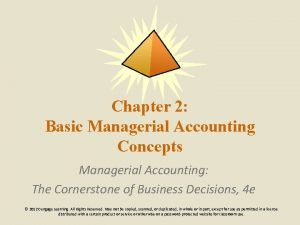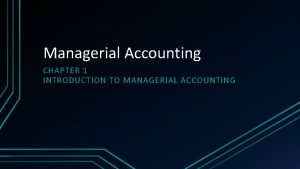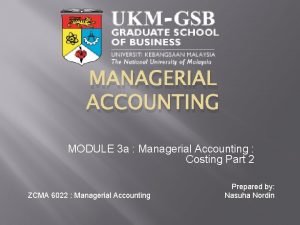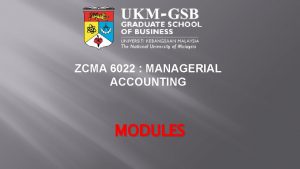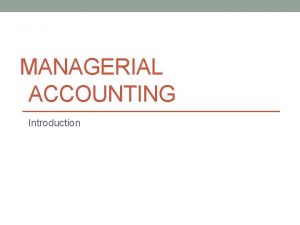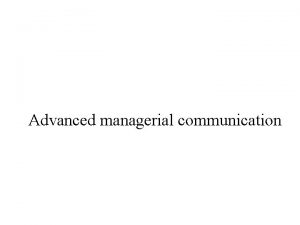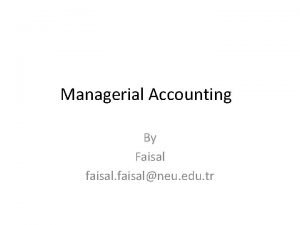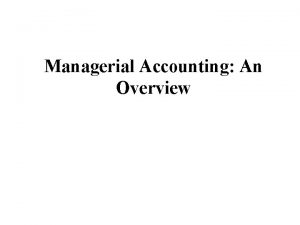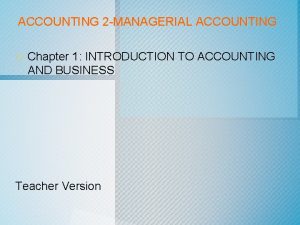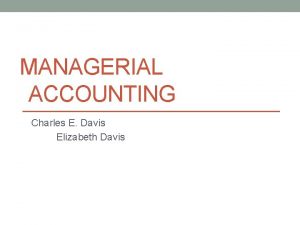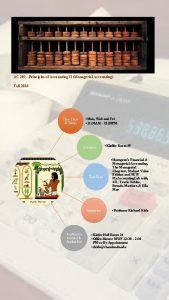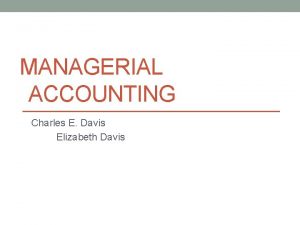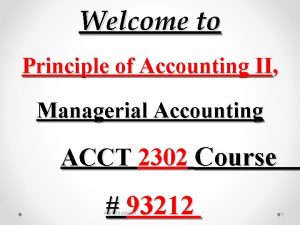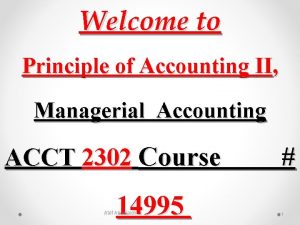Chapter 1 1 CHAPTER 1 MANAGERIAL ACCOUNTING Managerial



































- Slides: 35

Chapter 1 -1

CHAPTER 1 MANAGERIAL ACCOUNTING Managerial Accounting, Fourth Edition Chapter 1 -2

Managerial Accounting Basics Definition of Managerial Accounting A field of accounting that provides economic and financial information for managers and other internal users. Also called Management Accounting Chapter 1 -3

Comparing Managerial and Financial Accounting Similarities Both managerial and financial accounting deal with economic events of a business – Thus, interests overlap Both require that economic events be quantified and communicated to interested parties – Determining unit cost is part of managerial accounting, Reporting cost of goods manufactured is a part of financial accounting Chapter 1 -4 LO 1 Explain the distinguishing features of managerial accounting.

Comparing Managerial and Financial Accounting Differences Chapter 1 -5 LO 1 Explain the distinguishing features of managerial accounting.

Managerial Accounting Basics Management Functions Management’s activities and responsibilities can be classified into the following three broad functions: Planning Chapter 1 -6 Directing Controlling LO 2 Identify the 3 broad functions of management.

Good Ethics – Good Business Ethics All employees are expected to act ethically An increasing number of organizations have codes of business ethics Despite organizational efforts: Business scandals have caused massive investment losses and employee layoffs. Corporate fraud has increased 13% in last 5 years. Employee fraud – 60% of all fraud Intentional misstatement of financial reports Aka financial reporting fraud is most costly Chapter 1 -7

Good Ethics – Good Business Creating Proper Incentives Companies like Motorola, IBM, and Nike expend substantial resources to monitor and evaluate the actions of employees & managers. Monitoring can have the negative result of producing incentives for unethical actions. Employees may feel that they must succeed no matter what. Ineffective and unrealistic controls may also result in declining product quality. Chapter 1 -8

Good Ethics – Good Business Code of Ethical Standards Sarbanes-Oxley Act of 2002 Clarifies management’s responsibilities Certifications by CEO and CFO fairness of financial statements and adequacy of internal control Selection criteria for Board of Directors and Audit Committee Substantially increased penalties for misconduct IMA Statement of Ethical Professional Practices Chapter 1 -9

Managerial Cost Concepts Manufacturing Costs Manufacturing consists of activities and processes to convert raw materials into finished goods. In contrast, a merchandising firm sells goods in the form in which they were purchased. Manufacturing costs are typically classified as: Chapter 1 -10 LO 3 – Define three classes of manufacturing costs.

Manufacturing Costs Materials Raw Materials Basic materials and parts used in manufacturing process Materials Direct Materials Raw materials that can be physically and directly associated with the finished productduring the manufacturing process Chapter 1 -11 LO 3 Define three classes of manufacturing costs.

Manufacturing Costs Materials Indirect Materials Raw materials that cannot be easily associated with the finished product Not physically part of the finished product or they are an insignificant part of finished product in terms of cost Considered part of manufacturing overhead Chapter 1 -12 LO 3 Define three classes of manufacturing costs.

Manufacturing Costs Labor Direct Labor Work of factory employees that can be physically and directly associated with converting raw materials into finished goods Indirect Labor Work of factory employees that has no physical association with the finished product or for which it is impractical to trace costs to the goods produced Chapter 1 -13 LO 3 Define three classes of manufacturing costs.

Manufacturing Costs Manufacturing Overhead Costs that are indirectly associated with manufacturing the finished product Includes all manufacturing costs except direct materials and direct labor Allocation of overhead to products can present problems Also called factory overhead, indirect manufacturing costs, or burden Chapter 1 -14 LO 3 Define three classes of manufacturing costs.

Manufacturing Costs Review Question Which of the following is not an element of manufacturing overhead? : a. Sales manager’s salary. b. Plant manager’s salary. c. Factory repairman’s wages. d. Product inspector’s salary. Chapter 1 -15 LO 3 Define three classes of manufacturing costs.

Product Versus Period Costs Product Costs Components: direct material cost, direct labor cost, and manufacturing overhead Costs that are a necessary and integral part of producing the product Recorded as inventory when incurred, thus may be called inventoriable costs Not an expense until the finished goods inventory is sold then cost of goods sold Chapter 1 -16 LO 4 Distinguish between product and period costs.

Product Versus Period Costs Matched with revenue of a specific time period and charged to expense as incurred Non-manufacturing costs Deducted from revenues in period incurred to determine net income Includes all selling and administrative expenses Chapter 1 -17 LO 4 Distinguish between product and period costs.

Product Versus Period Costs Chapter 1 -18 LO 4 Distinguish between product costs and period costs.

Manufacturing Costs in Financial Statements Income Statement The income statement for a manufacturer is similar to that of a merchandiser except for the cost of goods sold section. Chapter 1 -19 LO 5 Explain the difference between a merchandising and a manufacturing income statement.

Manufacturing Costs in Financial Statements Cost of Goods Sold Components Merchandiser versus Manufacturer Chapter 1 -20 LO 5 Explain the difference between a merchandising and a manufacturing income statement.

Manufacturing Costs in Financial Statements Cost of Goods Sold Section of the Income Statement Chapter 1 -21 LO 5 Explain the difference between a merchandising and a manufacturing income statement.

Manufacturing Costs in Financial Statements Chapter 1 -22 LO 6 Indicate how cost of goods manufactured is determined.

Manufacturing Costs in Financial Statements Balance Sheet - Inventories Merchandising Company One category of inventory: Merchandise Inventory Chapter 1 -23 Manufacturing Company May have three inventories: Raw Materials Work in Process Finished Goods LO 7 Explain the difference between a merchandising and a manufacturing balance sheet.

Manufacturing Costs in Financial Statements Balance Sheet - Inventories Chapter 1 -24 LO 7 Explain the difference between a merchandising and a manufacturing balance sheet

Managerial Accounting Today Service Industry Trends U. S. economy, in general, has shifted toward an emphasis on providing services rather than goods Over 50% of U. S. workers are now employed by service companies Trend is expected to continue in the future Most of the techniques learned for manufacturing firms are applicable to service companies Chapter 1 -25 LO 8 Identify trends in management accounting.

Managerial Accounting Today Managerial Accounting Practices Value Chain Refers to all activities associated with providing a product or service For a manufacturing firm these include the following: Chapter 1 -26 LO 8 Identify trends in management accounting.

Managerial Accounting Today Managerial Accounting Practices Technological Change Enterprise Resource Planning (ERP) – software programs designed to manage all major business processes Computer-Integrated Manufacturing (CIM) – manufacturing products with increased automation Just-In-Time (JIT) Inventory Methods Inventory system in which goods are manufactured or purchased just in time for use Chapter 1 -27 LO 8 Identify trends in management accounting.

Managerial Accounting Today Managerial Accounting Practices Quality Increased emphasis on product quality because goods are produced only as needed Total Quality Management (TQM) - a philosophy of zero defects – Activity-Based-Costing (ABC) Allocates overhead based on use of activities Results in more accurate product costing and scrutiny of all activities in the value chain Chapter 1 -28 LO 8 Identify trends in management accounting.

Managerial Accounting Today Managerial Accounting Practices Theory of Constraints (“bottlenecks” ) limit the company’s potential profitability A specific approach to identify and manage these constraints in order to achieve company goals Balanced Scorecard Evaluates operations in an integrated fashion Uses both financial and non-financial measures Chapter 1 -29 Links performance measures to overall company objectives LO 8 Identify trends in management accounting.

Managerial Accounting Today Review Question Which of the following managerial accounting techniques attempts to allocate manufacturing overhead in a more meaningful manner? a. Just-in-time inventory. b. Total-quality management. c. Balanced scorecard. d. Activity-based costing. Chapter 1 -30 LO 8 Identify trends in management accounting.

All About You Outsourcing and Jobs To reduce costs and remain competitive many companies are turning to outsourcing “Outsourcing means hiring an outside supplier to provide elements of a product rather than producing them internally” While outsourcing can be to another provider within the U. S. , many professional services as well as manufacturing jobs have become candidates for outsourcing to foreign providers By 2015, it has been predicted that 3. 3 million service jobs will have been outsourced offshore. Chapter 1 -31

All About You Outsourcing and Jobs – What do you think? Do you think outsourcing really reduces costs? If costs are reduced, do you think that it justifies the loss of jobs to U. S. workers? What would you say to your employees whose jobs have been outsourced? Do you think that outsourced professional services performed in a foreign country or parts manufactured offshore will have the same quality and standards as those performed/manufactured in the U. S. ? Chapter 1 -32

Chapter Review - Brief Exercise 1 -5 Indicate whether each of the following costs of an automobile manufacturer would be classified as direct materials, direct labor, or manufacturing overhead. ______ DM ______ DL ______ MO ______ DM ______ MO Chapter 1 -33 a. b. c. d. e. f. g. h. Windshield Engine Wages of assembly line worker Depreciation of factory machinery Factory machinery lubricants Tires Steering wheel Salary of painting supervisor

Chapter Review - Brief Exercise 1 -6 Identify whether each of the following costs should be classified as product costs or period costs. ______ Product ____________ Period ____________ Product Chapter 1 -34 a. b. c. d. e. f. Manufacturing overhead Selling expenses Administrative expenses Advertising expense Direct labor Direct material

Copyright © 2008 John Wiley & Sons, Inc. All rights reserved. Reproduction or translation of this work beyond that permitted in Section 117 of the 1976 United States Copyright Act without the express written permission of the copyright owner is unlawful. Request for further information should be addressed to the Permissions Department, John Wiley & Sons, Inc. The purchaser may make back-up copies for his/her own use only and not for distribution or resale. The Publisher assumes no responsibility for errors, omissions, or damages, caused by the use of these programs or from the use of the information contained herein. Chapter 1 -35
 Managerial accounting chapter 5 solutions
Managerial accounting chapter 5 solutions Managerial accounting chapter 13 solutions
Managerial accounting chapter 13 solutions Managerial accounting chapter 9
Managerial accounting chapter 9 Chapter 2 solutions managerial accounting
Chapter 2 solutions managerial accounting Chapter 6 managerial accounting solutions
Chapter 6 managerial accounting solutions Conversion cost formula
Conversion cost formula Introduction to managerial accounting
Introduction to managerial accounting Managerial accounting jiambalvo
Managerial accounting jiambalvo Chapter 1 managerial accounting
Chapter 1 managerial accounting Managerial accounting and cost concepts
Managerial accounting and cost concepts Managerial accounting chapter 8
Managerial accounting chapter 8 Chapter 1 managerial accounting and cost concepts
Chapter 1 managerial accounting and cost concepts Managerial accounting chapter 1
Managerial accounting chapter 1 Managerial accounting chapter 3
Managerial accounting chapter 3 The scope of management accounting includes
The scope of management accounting includes Jiambalvo managerial accounting
Jiambalvo managerial accounting How managerial accounting adds value to the organization
How managerial accounting adds value to the organization Financial and managerial accounting weygandt kimmel kieso
Financial and managerial accounting weygandt kimmel kieso Managerial accounting cost concepts
Managerial accounting cost concepts Accounting and the business environment
Accounting and the business environment What is cma
What is cma Managerial accounting concepts and principles
Managerial accounting concepts and principles Managerial accounting james jiambalvo
Managerial accounting james jiambalvo The nature of management accounting
The nature of management accounting Manufacturing accounting basics
Manufacturing accounting basics Distinguishing features of managerial accounting
Distinguishing features of managerial accounting Managerial accounting and the business environment
Managerial accounting and the business environment Advanced cost and management accounting ppt
Advanced cost and management accounting ppt Financial and managerial accounting wild
Financial and managerial accounting wild Dol managerial accounting
Dol managerial accounting Intermediate accounting chapter 1
Intermediate accounting chapter 1 Computerised accounting system notes
Computerised accounting system notes Accounting period concept in accounting
Accounting period concept in accounting Advanced corporate accounting ppt
Advanced corporate accounting ppt Ecomics
Ecomics Explain the fundamental concepts of managerial economics
Explain the fundamental concepts of managerial economics
